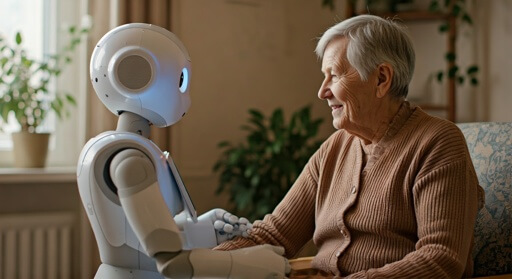
Page contents
Page contents
The Digital Revolution has been underway since the 1980s, with tech seeping further and further into daily life. Care home technology is no exception.
Artificial Intelligence is the latest innovation that is potentially going to change the way we live, for better or for worse. Below are some ways that AI in care homes and digital technology are being used to (hopefully) improve care.
How can AI monitoring keep residents safe in care homes?
Sophisticated sensor systems are being piloted in care homes. They detect certain sounds or changes in behaviour which may mean the resident needs assistance or medical attention. They then immediately alert staff.
The sensors can detect:
- If a resident calls for help
- If a resident falls
- Restlessness or distress
- Pain (one app being used in some care homes is PainChek, an AI-driven system specifically designed to identify if a resident is in pain)
- Coughing or choking
- Air quality
- Potential accidents
- Increased trips to the toilet
The care home technology can record this data, highlighting patterns and out-of-ordinary events. It may be particularly helpful for residents who are not always able to vocalise what is wrong, such as those who live with dementia or other conditions that effect communication.
These systems must be put in place only with each resident’s consent.
A previous pilot scheme saw a 20% reduction in hospital admissions thanks to the technology and a huge 75% fall in night time checks that were not necessary. This suggests that this tech could make care more efficient and cost-effective.
What are virtual ward beds in care homes?
As a means of increasing patient comfort and reducing hospital stays, the NHS sometimes uses ‘virtual wards’. These are when a person receives the same care they would in hospital but where they live, including residents of care homes.
The patient is admitted to the virtual ward and under the care of a team of medical professionals. This could include doctors, nurses, occupational therapists, dieticians, anyone who would be involved in their care if they were physically in hospital.
During a hospital stay, nurses come round several times a day to do their ‘obs’. This is where they take readings of things like your blood pressure, heart rate and temperature. In a virtual ward, a care home resident’s carers can take these observations, and submit them to the hospital digitally or over the phone. Real medics then review them and make decisions, as they would in hospital.
How will AI change medication management in care homes?
Medication management used to be done on large sheets of paper called MAR (Medication Administration Records) sheets. Care homes can now use an electronic version of this (eMAR).
Recording medication digitally allows care homes to store and retrieve information on each resident’s medication highly efficiently. Smart systems also claim to drastically reduce room for human error, thereby being safer than the old paper MAR sheets.
On a smaller scale, digital medication dispensers have been around for years. They provide a person with the right medication at the right time, which is particularly helpful for people who have difficulties with memory and organisation due to conditions like dementia.
Modern versions of medication dispensers are connected to apps, so that a person’s relative or carer manages their medication more smoothly and if necessary, remotely.
Do care homes use digital records?
As with medication management, care home records are moving into the digital space. The CQC is supportive of this, particularly the NHS’s Digitising Social Care programme.
Digital records are more efficient and accessible than their paper counterparts. They free up physical space in the care home and can be more secure if proper security systems are in place.
Could smart speakers help care home residents to communicate?
A 2019 US study concluded that smart speakers in care homes offered numerous benefits for both residents and staff.
Smart speakers open opportunities to residents who struggle to operate electronics, whether that’s through limited technological ability, mobility issues or conditions like dementia and arthritis.
Depending on what the speaker is linked to, the resident can simply ask for their chosen music on, audiobooks, volume changes or lights dimmed, without having to call a carer for help. They can also use it for questions, jokes and phoning family and friends, making it a useful tool for social connection.
Is AI being used for companionship in care homes?
Robots have been used as part of care home technology for some time. Pet therapy robots are cuddly, quite simple animatronics designed to give residents the mental health benefits that come with caring for real pets.
However, AI and robotics can go further.
In January, a Swiss robotics expert from the University of Geneva made headlines when she created a robot version of herself to keep her mum company in a care home. Professor Nadia Thalmaan created an AI powered robot called Nadia who can recall people’s faces and information about them, make conversation and speak to residents in their own language.
There have been other robots in care homes such as Pepper, a fleet of companion robots. They were intended to fill gaps between real human interaction and their trial found that they did improve residents’ mental health.
More recent criticism of Pepper highlights problems with implementing robots in care homes, particularly financial.
The people developing AI innovations are naturally enthusiastic about it, but whether it will really improve care, and whether people actually want it, time will tell.


